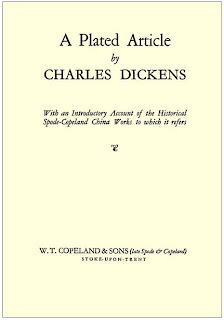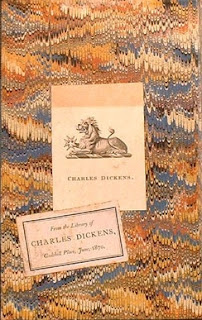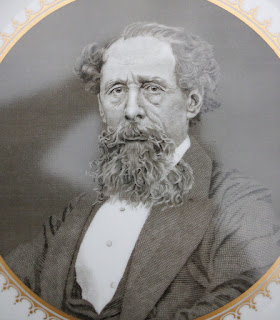 |
| A Plated Article (cover detail) |
In 1852 Charles Dickens, the famous author, visited the Spode factory then under the ownership of the Copeland family. Dickens was by now a man who today we would describe as a celebrity and it must have been an exciting day for all those at the factory in Stoke. Dickens being Dickens he published a story about his visit to the factory in his magazine
Household Words. It was called
A Plated Article. His story is told from the point of view of the plate and it takes you on a tour through the factory. For those with special interests in techniques of manufacture at this period it is fascinating and also describes how mocha ware is made. Click
here and then scroll down to read about mocha ware.
You can read the story in full online on many websites during this bicentenary year of Dickens' birth. As well as reading this story you can also get involved helping to edit his works on the website
Dickens Journals Online - just click the link which takes you to Volume V page 117 and simply read the relevant Spode pages ......or explore further.
A Plated Article was published separately by the Spode company in many versions over the years. Little books with simply the article itself were produced or a booklet could include company history and product detail with images of Spode pots illustrating the pages.
 |
| A Plated Article (inside cover) |
 |
| A dinner plate from Dickens' service, pattern D4970 with his crest |
But Dickens was not just a visitor to the Spode company he was also a customer and ordered his specially commissioned 'badged' table services from Spode in 1867. He chose designs in patterns D4680, an elegant gold decorated breakfast pattern, and dinner ware in pattern D4970. The latter is a simple border design of 2 lines and Dickens had a crest with his initials CD added to the pieces in gold. A black and white illustration can be seen on page 29 of
Spode & Copeland Marks & Other Relevant Intelligence by Robert Copeland. A record of the design D4970, 'badge' and the date of invoice recorded as '
invoiced June 3th 1867' (sic) is in the Spode archive in the 2nd Arms Book on page 113.
It seems Dickens did not actually have a formal coat of arms granted by the Royal College of Arms but used a crest anyway! He also used it on his personal seal and as the design for his book plate - an example of which is in the Berg Collection in New York Public Library.
 |
| Dickens' book plate |
A piece of the dinner service is in the Spode museum's collection and, possibly, even the tiny hand engraved copper plate from which the crest was printed. In the Spode archive there is a letter from Dickens' son confirming the ware belonged to his father. Spode customer records are rare in the archive so a plate with CD on it could have been made for anybody with those initials - confirmation from a family member was useful. Also it was not known that Dickens had also ordered wares in pattern D4680 until an enquirer approached the museum with a piece some years ago.
In 1970 to mark the centenary of Dickens' death Spode produced a presentation plate using the badge from his dinner service, but now set in a stylised shield, with a portrait of the great man in the plate centre. The centre was engraved by one of the best ever Spode engravers - Frank Boothby. The close-up on this page shows the stunning result of his engraving work but I don't know from what portrait this engraving was taken.
 |
| Spode, Dickens Plate, 1970 |
 |
| Dickens Plate, detail, 1970 |
From the mid-1960s to about the mid-1980s Spode specialised in what they called 'presentation' plates and vases. They may even have started the idea. High quality bone china pieces, in satin lined boxes and with an information leaflet about the object, made fine expensive gifts for individuals and also for corporate gifts fashionable in that era. Pieces were produced for example for a big anniversary of a famous cathedral, Wimbledon Lawn Tennis Club celebrations, army and RAF anniversaries, Royal occasions, privately commissioned pieces or those which Spode simply thought would sell successfully. There was even a plate in cobalt blue and gold celebrating the enlargement of the EEC.
The secret of the success behind these pieces was a combination of detailed research, usually by Robert Copeland, superb skill and attention to detail in the design, the very high quality of Spode's bone china and decoration combined with elegant packaging and well-researched marketing material.







